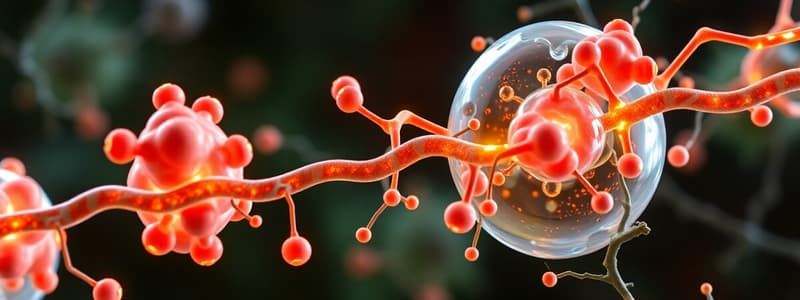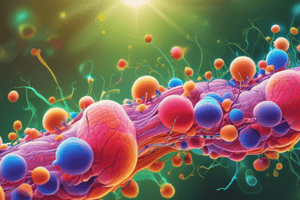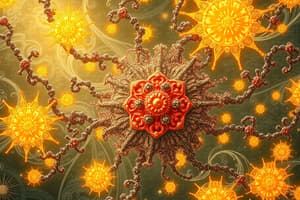Podcast
Questions and Answers
Which of the following cellular activities require energy?
Which of the following cellular activities require energy?
- Passive Transport
- Photosynthesis
- Cell Division (correct)
- Osmosis
What is the primary role of ATP in the cell?
What is the primary role of ATP in the cell?
- Energy carrier (correct)
- Building cellular structures
- Transport of nutrients
- Storage of genetic information
Where does ATP synthesis occur in the cell?
Where does ATP synthesis occur in the cell?
- Mitochondria (correct)
- Nucleus
- Cell membrane
- Ribosomes
What is the relationship between glucose and ATP in terms of energy storage?
What is the relationship between glucose and ATP in terms of energy storage?
Which of the following definitions accurately describes autotrophs?
Which of the following definitions accurately describes autotrophs?
What is the primary function of the active site on an enzyme?
What is the primary function of the active site on an enzyme?
Which model describes how enzymes interact with substrates?
Which model describes how enzymes interact with substrates?
How does temperature affect enzyme activity according to the text?
How does temperature affect enzyme activity according to the text?
What is the optimal pH range for most enzymes in living cells?
What is the optimal pH range for most enzymes in living cells?
What happens to enzyme activity as the concentration of substrates increases?
What happens to enzyme activity as the concentration of substrates increases?
Denaturation of an enzyme is primarily caused by which of the following factors?
Denaturation of an enzyme is primarily caused by which of the following factors?
What effect does increasing enzyme concentration have on the rate of reaction?
What effect does increasing enzyme concentration have on the rate of reaction?
What is a property of water that allows life to exist under ice?
What is a property of water that allows life to exist under ice?
How do substrates interact with enzymes during a reaction?
How do substrates interact with enzymes during a reaction?
Which of the following best describes a polar bond?
Which of the following best describes a polar bond?
What is the main reason water is considered the universal solvent?
What is the main reason water is considered the universal solvent?
How does water's high specific heat affect its temperature change?
How does water's high specific heat affect its temperature change?
In what forms can water be found in nature?
In what forms can water be found in nature?
What role do hydrogen bonds play in the structure of water molecules?
What role do hydrogen bonds play in the structure of water molecules?
What impact does water's ability to dissolve most substances have on ecosystems?
What impact does water's ability to dissolve most substances have on ecosystems?
How does water's expansion as it freezes benefit aquatic life?
How does water's expansion as it freezes benefit aquatic life?
What is the primary output of anaerobic respiration in animal cells?
What is the primary output of anaerobic respiration in animal cells?
Where does the Krebs cycle occur within the cell?
Where does the Krebs cycle occur within the cell?
Which of the following is not an output of the electron transport chain?
Which of the following is not an output of the electron transport chain?
How many times does the Krebs cycle turn per glucose molecule?
How many times does the Krebs cycle turn per glucose molecule?
Which type of fermentation produces lactic acid as a byproduct?
Which type of fermentation produces lactic acid as a byproduct?
What is needed for aerobic respiration to occur?
What is needed for aerobic respiration to occur?
What are the inputs for the electron transport chain?
What are the inputs for the electron transport chain?
What is the net gain of ATP from glycolysis?
What is the net gain of ATP from glycolysis?
What is the purpose of enzymes in chemical reactions?
What is the purpose of enzymes in chemical reactions?
Which reagent forms pinkish clumps when the target molecule is present?
Which reagent forms pinkish clumps when the target molecule is present?
What color indicates a positive test for proteins when using Biuret’s Reagent?
What color indicates a positive test for proteins when using Biuret’s Reagent?
What is represented by a molecular formula?
What is represented by a molecular formula?
Which of the following statements about enzymes is true?
Which of the following statements about enzymes is true?
What is the maximum number of electrons that can occupy the 2nd energy level?
What is the maximum number of electrons that can occupy the 2nd energy level?
What happens to starch when Lugol's Iodine solution is present?
What happens to starch when Lugol's Iodine solution is present?
How can you calculate the number of neutrons in an atom?
How can you calculate the number of neutrons in an atom?
In the periodic table, what does the atomic number represent?
In the periodic table, what does the atomic number represent?
What is activation energy?
What is activation energy?
What is the correct configuration of electrons in a hydrogen atom?
What is the correct configuration of electrons in a hydrogen atom?
Which characteristic describes most enzyme names?
Which characteristic describes most enzyme names?
What is the negative test result for Sudan IV?
What is the negative test result for Sudan IV?
What information is NOT contained in a structural formula?
What information is NOT contained in a structural formula?
Which of the following statements about neutrons is correct?
Which of the following statements about neutrons is correct?
Which subatomic particle can be found in the orbitals around the nucleus?
Which subatomic particle can be found in the orbitals around the nucleus?
Flashcards
Molecular formula
Molecular formula
A chemical formula representing the total number of atoms and types of atoms present in a molecule.
Structural formula
Structural formula
A chemical formula representing the arrangement and bonding of atoms in a molecule.
Proton
Proton
The positively charged particle located within the nucleus of an atom. Plays a key role in chemical bonding.
Neutron
Neutron
Signup and view all the flashcards
Electron
Electron
Signup and view all the flashcards
Atomic number
Atomic number
Signup and view all the flashcards
Atomic mass
Atomic mass
Signup and view all the flashcards
Bohr model
Bohr model
Signup and view all the flashcards
Covalent Bond
Covalent Bond
Signup and view all the flashcards
Polar Molecule
Polar Molecule
Signup and view all the flashcards
Hydrogen Bond
Hydrogen Bond
Signup and view all the flashcards
Universal Solvent
Universal Solvent
Signup and view all the flashcards
High Specific Heat
High Specific Heat
Signup and view all the flashcards
Water Expands When Frozen
Water Expands When Frozen
Signup and view all the flashcards
States of Matter
States of Matter
Signup and view all the flashcards
Polar Bond
Polar Bond
Signup and view all the flashcards
Chemical Test Solution
Chemical Test Solution
Signup and view all the flashcards
Metabolic Reaction
Metabolic Reaction
Signup and view all the flashcards
Activation Energy
Activation Energy
Signup and view all the flashcards
Catalyst
Catalyst
Signup and view all the flashcards
Enzyme
Enzyme
Signup and view all the flashcards
Catabolic Reaction
Catabolic Reaction
Signup and view all the flashcards
Anabolic Reaction
Anabolic Reaction
Signup and view all the flashcards
What are metabolic reactions?
What are metabolic reactions?
Signup and view all the flashcards
What is ATP?
What is ATP?
Signup and view all the flashcards
What is phosphorylation?
What is phosphorylation?
Signup and view all the flashcards
What are autotrophs?
What are autotrophs?
Signup and view all the flashcards
What are heterotrophs?
What are heterotrophs?
Signup and view all the flashcards
What are enzymes?
What are enzymes?
Signup and view all the flashcards
How are enzymes specific?
How are enzymes specific?
Signup and view all the flashcards
What is an active site?
What is an active site?
Signup and view all the flashcards
How does temperature affect enzyme action?
How does temperature affect enzyme action?
Signup and view all the flashcards
How does pH affect enzyme action?
How does pH affect enzyme action?
Signup and view all the flashcards
How does enzyme concentration affect the rate of reaction?
How does enzyme concentration affect the rate of reaction?
Signup and view all the flashcards
How does substrate concentration affect the rate of reaction?
How does substrate concentration affect the rate of reaction?
Signup and view all the flashcards
Why are enzymes important for life?
Why are enzymes important for life?
Signup and view all the flashcards
Glycolysis
Glycolysis
Signup and view all the flashcards
Fermentation
Fermentation
Signup and view all the flashcards
Krebs Cycle
Krebs Cycle
Signup and view all the flashcards
Electron Transport Chain
Electron Transport Chain
Signup and view all the flashcards
Cellular Respiration
Cellular Respiration
Signup and view all the flashcards
Study Notes
No specific text or questions provided. Please provide the text or questions you would like me to create study notes for.
Studying That Suits You
Use AI to generate personalized quizzes and flashcards to suit your learning preferences.




